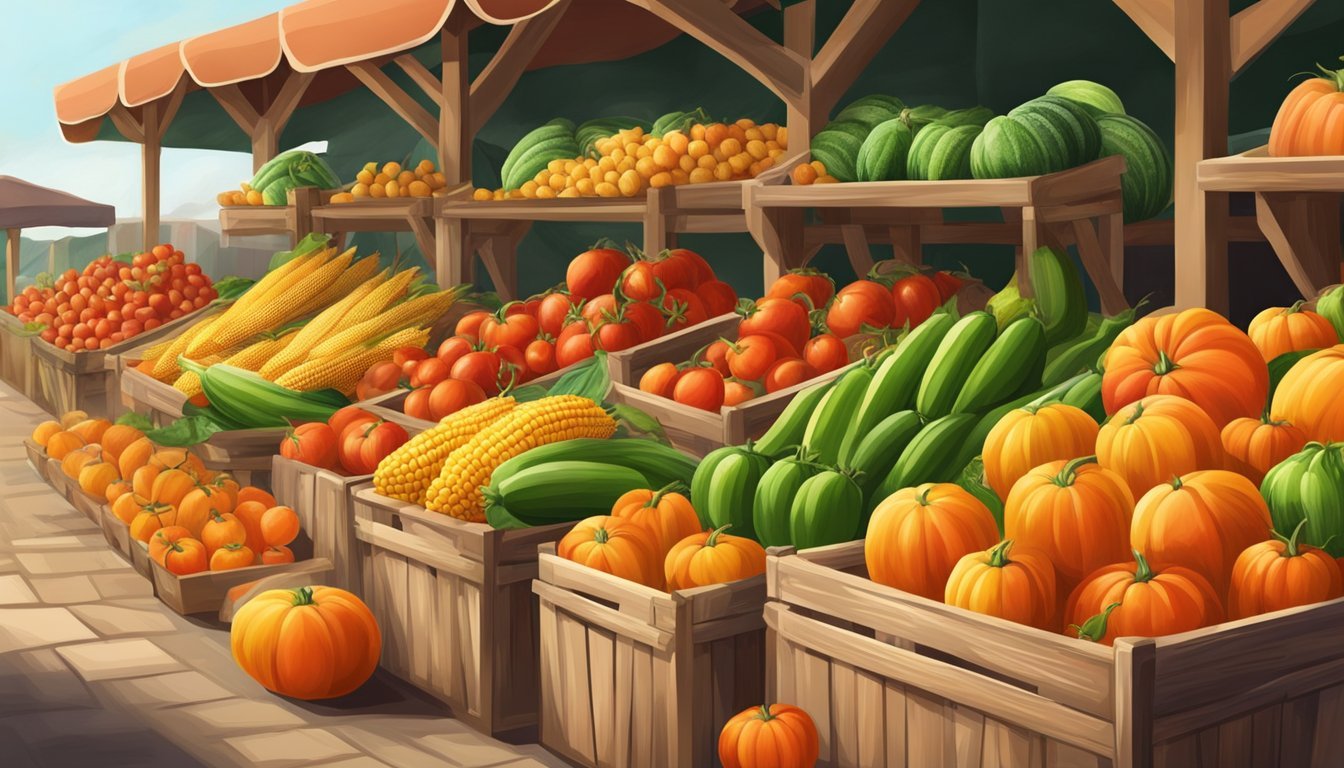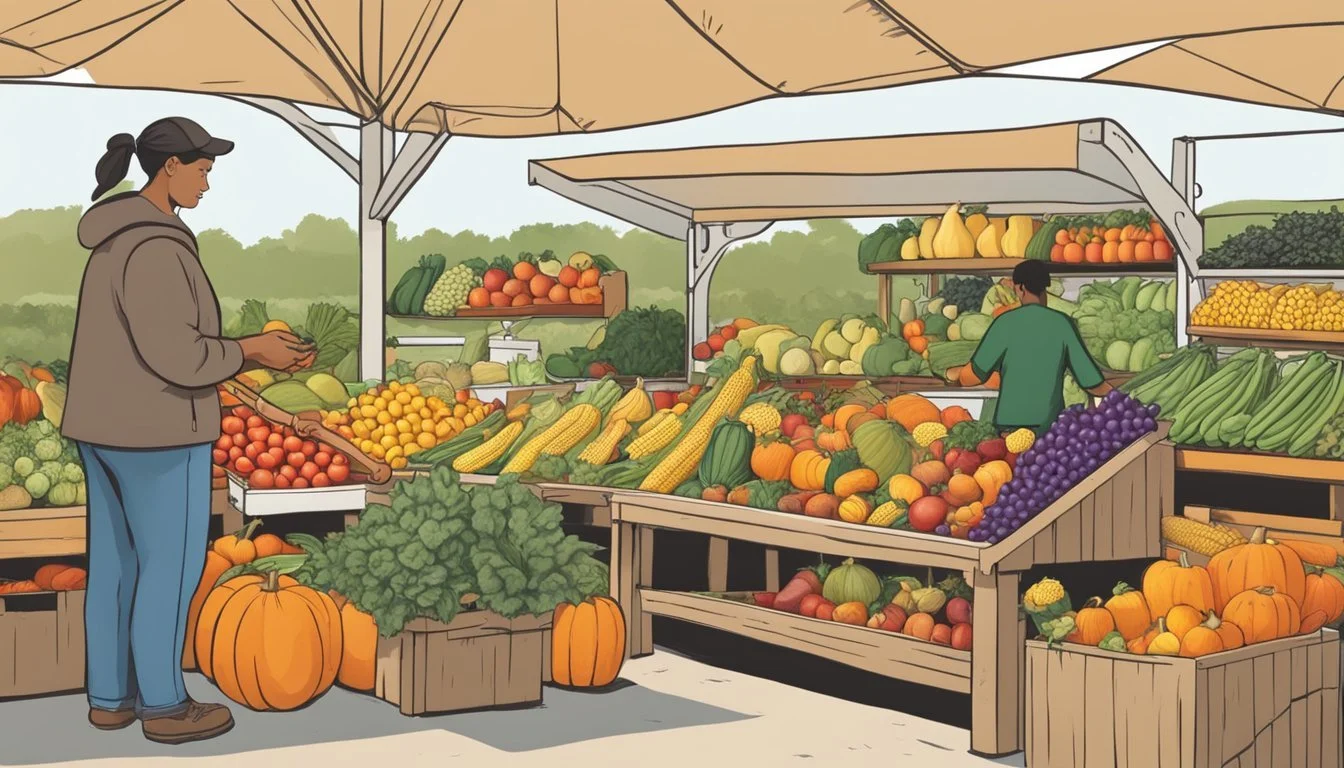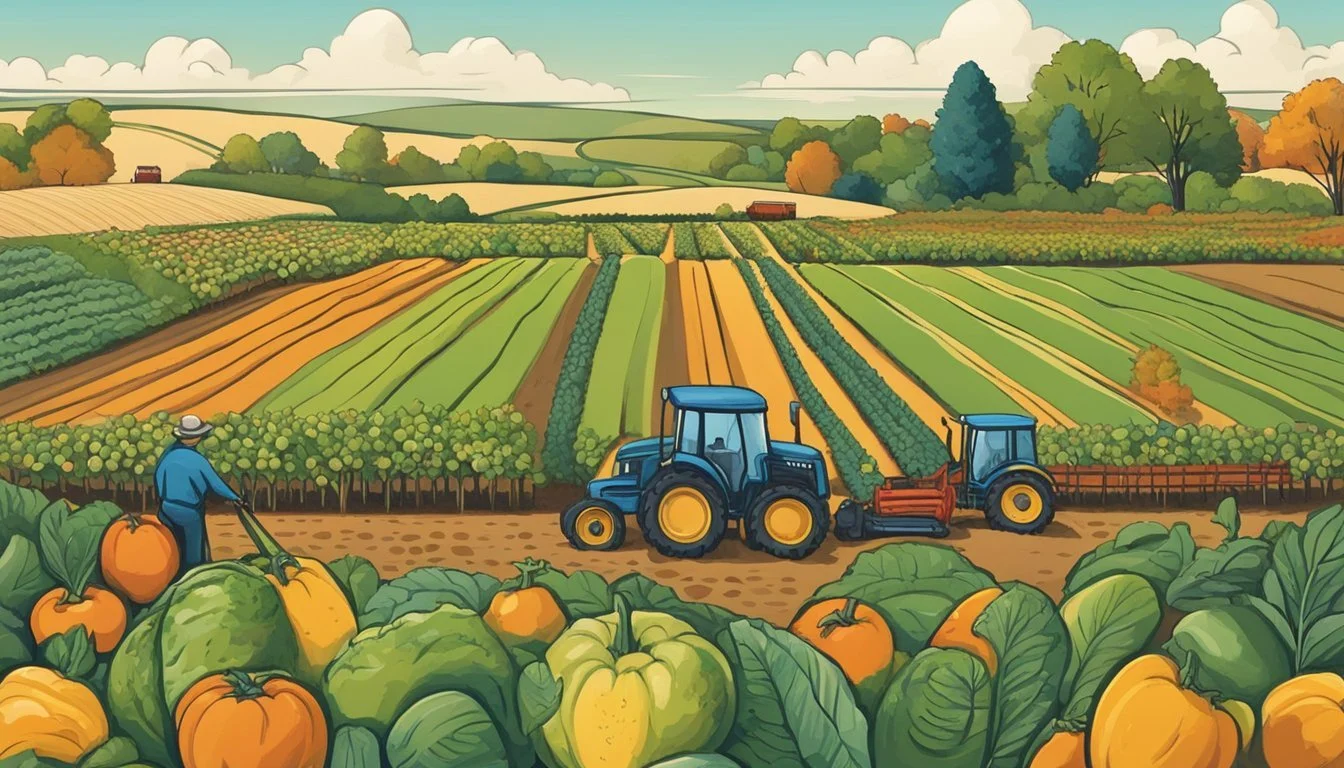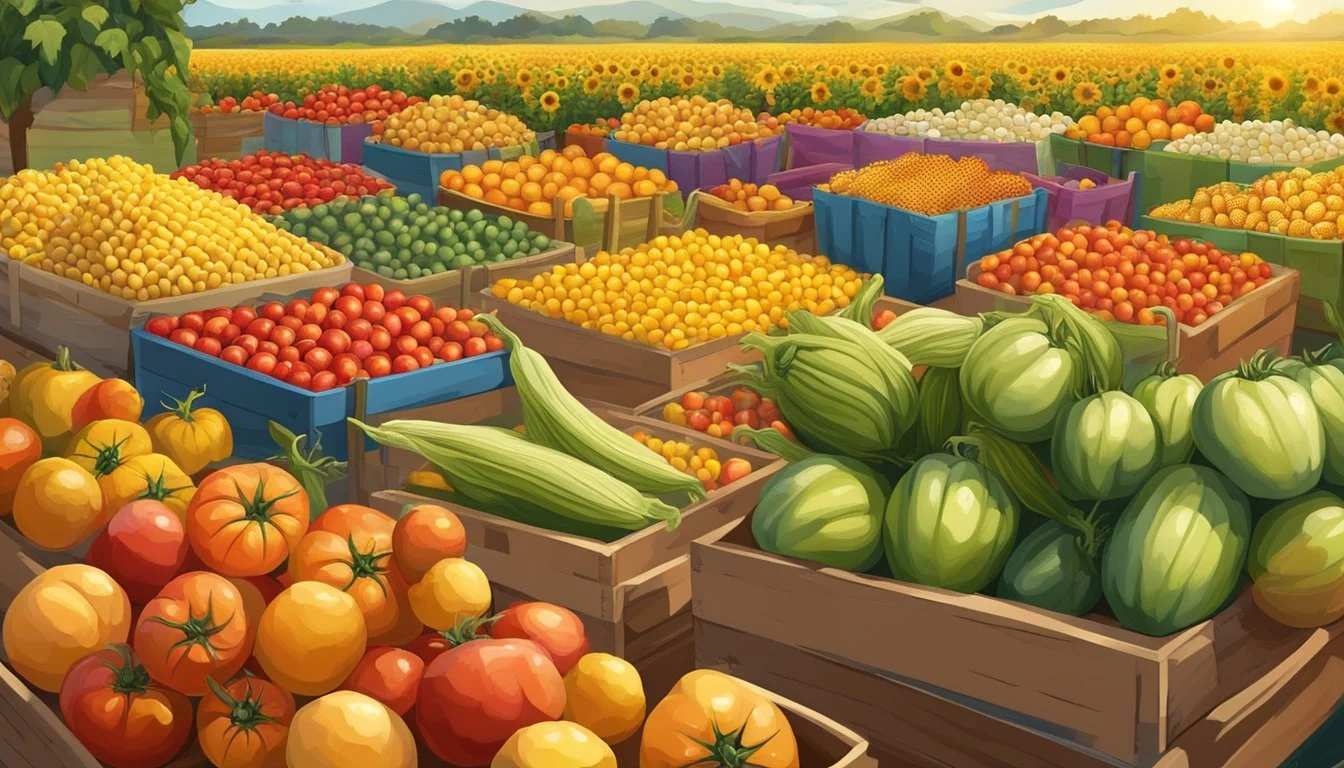Nebraska Seasonal Fruit & Vegetables in September
A Guide to the Best Picks
This Article is Part of our Nebraska Seasonal Fruit & Veg Calendar
September in Nebraska marks a transitional period where summer's bounty begins to give way to the autumnal harvest. During this month, the state's agricultural focus shifts as the warm-weather crops reach their peak and cool-weather produce starts to come into season. Fruit (What wine goes well with fruits?) varieties, like apples (how long do apples last?), are particularly noteworthy, as Nebraska’s climate is conducive to growing crisp and juicy varieties. Apples such as Gala, Golden Delicious, Honey Crisp, and Jonagold, are known for their flavor and are harvested at this time.
Vegetable gardens and farmers’ markets also see a variety of produce. Sweet corn, a staple of Nebraska summers, often has its final harvests in the early part of the month. Gardeners and local growers harvest robust vegetables like pumpkins and squash, which are just beginning to come into season. These fall favorites are accompanied by a range of other produce that thrives in the cooler weather, such as root vegetables and hearty greens.
With ample daylight and moderate temperatures, September is a vibrant time for Nebraska's growers and consumers alike to enjoy a diverse selection of fresh, local fruits and vegetables. The harvest during this month encompasses the tail end of summer’s flavors as well as the initial offerings that hint at the coming autumn. This ensures a rich mix of produce available, reflecting both the end of one growing season and the beginning of another.
Overview of Nebraska's Growing Seasons
In Nebraska, the diverse climate results in a distinct growing season for a variety of fruits and vegetables. With a season that transitions from the cold snaps of spring to the warm, long days of summer, and subsequently into the mildness of fall, gardeners and farmers plan their planting and harvest times meticulously.
Spring marks the start of the planting season, usually beginning in late April or early May, with the risk of frost diminishing. Gardeners often begin with cool-weather crops during this period. As summer approaches, typically by June, the state sees longer days and warmer temperatures, ideal for growing a wide range of produce. This is the peak time for planting warm-season crops, which will be nurtured by the long summer days.
September in Nebraska is a critical time for both planting and harvest. While some late summer crops are being gathered, many fall varieties are also being sown. August serves as a preparatory month for the transition from summer harvesting to fall planting.
The arrival of fall often brings the harvest of hearty vegetables that thrive in cooler temperatures, with many crops being picked through October and some even into November, weather permitting. September provides a blend of both late summer and early fall produce, offering a bounty that reflects the state's agricultural versatility.
Month Planting Harvesting June - Warm-season crops - Early spring crops August - Fall vegetables - Summer produce September - Some fall crops - Late summer & early fall produce October - - Fall harvest November - - Late fall vegetables
Nebraska's growing seasons demonstrate the state's capacity to support a thriving agricultural environment, where timing is essential and each month has its role to play.
Seasonal Fruits and Vegetables Available in September
September in Nebraska is a bountiful time, with a diverse range of fruits and vegetables reaching their peak harvest season.
Fruits
Apples: The apple harvest is underway with a variety of species ripe for picking.
Pears: Crisp and sweet, pears are now in their prime.
Plums: Plentiful and juicy, plums are a seasonal delight this month.
Grapes: Vineyards are bustling as grapes reach perfect sweetness.
Peaches: Last chances to enjoy the succulent flavors of late-season peaches.
Vegetables
Tomatoes: Full-flavored tomatoes are abundant in gardens and markets.
Sweet Corn: Sweet corn is at its best, with kernels that are tender and filled with flavor.
Peppers: Both sweet and spicy varieties are now available.
Eggplants (What wine goes well with eggplant?): Thick-skinned and rich, eggplants continue to be a versatile vegetable choice.
Pumpkins: Early varieties of pumpkins may start to appear by the end of the month.
Kale: Hardy and nutritious, kale is an excellent green for cool-season dishes.
Winter Squashes: Various winter squashes make their debut, offering a precursor to autumn flavors.
Brussels Sprouts: These are just beginning to come into season, offering a taste of the coming fall.
Cabbage: Robust and ready for harvest, cabbage is ideal for slaws and stews.
Greens: A variety of greens are available for salads and cooking.
Selecting and Storing Seasonal Produce
When choosing seasonal fruits and vegetables in Nebraska during September, individuals should look for signs of freshness and ripeness to ensure flavor. For instance, sweet corn should have bright green husks and moist stems. Tomatoes, often juicy and flavorful this time of year, should have a deep color and firm skin. Apples, which may range from tart to sweet, are to be firm and free from bruises.
After selection, proper storage is crucial to maintain the quality of the produce. Individuals should store corn in the refrigerator with its husks on to preserve its crispness. Tomatoes, on the other hand, are best kept at room temperature away from direct sunlight to enhance their ripening and maintain their flavor. Apples can be kept in a cool, dry place or refrigerated; they tend to last longer when stored in a crisp drawer away from vegetables.
Here is a brief guide for September produce in Nebraska:
Fruit Selection Storage Sweet Corn Bright green husks, moist stems Refrigerate with husks Tomatoes Deep color, firm skin Room temperature, away from sunlight Apples Firm, free from bruises Cool, dry place or refrigerated
Vegetables also have specific selection and storage guidelines:
Vegetable Selection Storage Potatoes Firm, no sprouts or green tint Cool, dark, well-ventilated space Zucchini Shiny skin, firm texture Refrigerated in a plastic bag
Consumers are encouraged to enjoy their produce raw or cooked, keeping in mind the best practices for selection and storage to maximize flavor and longevity.
Preparation and Recipe Suggestions
When incorporating Nebraska's seasonal fruits and vegetables into recipes during September, creativity and simplicity can coexist to highlight the natural flavors. Fruits like apples and pears are versatile; they can be eaten raw for their crisp, juicy textures, or baked into desserts for a tender, sweet experience. Vegetables such as cauliflower and bell peppers also offer a range of uses, from raw crudités that celebrate their fresh crunch to roasted dishes (What wine goes well with roasted dishes?) which enhance their natural sweetness.
For fruit preparation, consider the following suggestions:
Apples:
Raw: Sliced thinly for salads or served with cheese.
Tender: Baked into an apple crisp or simmered into homemade applesauce.
Pears:
Raw: Added to a spinach salad for a sweet contrast.
Tender: Poached in red wine for an elegant dessert.
Vegetable preparation can be just as diverse:
Cauliflower:
Raw: Broken into florets for a healthy snack with dip.
Tender: Roasted with herbs as a side dish or puréed into a creamy soup.
Bell Peppers:
Raw: Julienned for a colorful addition to salads.
Tender: Stuffed with a mix of quinoa, tomatoes, and cheese, then baked.
Recipes that celebrate Nebraska's September bounty are abundant. Here are some ideas that utilize the best of the season:
Apple Oatmeal Pancakes: A breakfast delight that combines tender, cooked apples with hearty oats.
Blackberry Chia Pudding: A vibrant dessert or snack packed with juicy blackberries.
Roasted Pepper Salsa Verde: A tangy salsa made with roasted green chiles, perfect for dipping or as a taco topping.
Remember, the key to making the most of September's harvest is to let the natural flavors shine, whether enjoyed raw or transformed into warm, tender dishes.
Agricultural Practices in Nebraska
Nebraska's agriculture is diversified and technologically advanced, focusing on sustainable methods to produce a variety of crops. Effective soil management and disease control are pivotal for the state's agricultural success.
Sustainable Farming
Nebraska farmers employ sustainable farming practices to maintain soil health and ensure the long-term viability of their land. They use crop rotation to preserve soil nutrients and prevent erosion. Precision agriculture technologies are widespread, allowing for efficient use of water and fertilizers. Integrated Pest Management (IPM) practices help control pests with minimal environmental impact. These methods contribute to the health of the entire ecosystem.
Fertilizer application: tailored to soil needs
Water usage: monitored to minimize waste
Disease control: executed using environmentally friendly methods
Crop Varieties
The state's farmers grow a wide range of crop varieties adapted to the regional climate and soil conditions. High-quality seeds are selected for robustness and disease resistance. These crops undergo careful pruning and management to ensure optimal yield.
Trees: Specially bred for Nebraska's climate
Leaves and soil: Regularly tested for signs of disease or nutrient deficiency
Varieties:
Vegetables: Tomatoes, sweet corn, and more harvested in September
Fruits: Apples like Paula Red and Honey Crisp flourish in the fall
By focusing on sustainable farming and diversity in crop varieties, Nebraska agriculture continues to thrive.
Seasonal Planting and Harvesting Calendar
In Nebraska, September marks a transitional period in the agricultural calendar, bridging the end of summer harvests and the arrival of fall produce. Gardeners and farmers are busy during this month, as the planting and harvest activities continue in earnest.
Harvest in September:
Fruits: Apples, pears, and plums are typically ripe for picking.
Vegetables: A variety of vegetables such as sweet corn, tomatoes, peppers, cucumbers, zucchini, and green beans are still available.
Planting in September:
It is an opportune time to plant cool-season crops that will mature in the cooler temperatures of late fall. These include:
Radishes
Spinach
Lettuces
Kale
Looking ahead, October and November are important months for the harvest of pumpkins and winter squash, while preparations for the next season's crops begin.
Fall Planting for Spring Harvest:
Garlic cloves (how long do cloves last?) and shallots, when planted in October, can establish roots before the frost and will be ready for harvest in the spring and early summer.
By February and March, Nebraska's growers are planning and starting seedlings indoors for crops like tomatoes and peppers, which will be transferred outside after the last frost, typically occurring in April or May.
September's gardening activities set the stage for a bountiful autumn and lay the groundwork for the following year's spring and summer harvests. It's a critical month for planting, harvesting, and preparing for the cooler months ahead.
Health Benefits of Seasonal Eating
Eating fruits and vegetables at their seasonal peak offers multiple health benefits. When produce is fresh, nutrient content is often at its highest. Seasonal fruits and vegetables harvested in Nebraska during September, such as apples, plums, and squash, are rich in vitamins, minerals, and antioxidants essential for maintaining good health.
Consuming a variety of seasonal produce can lead to a more nutrient-diverse diet. Each fruit and vegetable has its unique profile of health-promoting substances, including dietary fiber, which supports digestive health. For instance:
Apples: Rich in fiber and vitamin C, contributing to immune and digestive health.
Plums: Contain vitamins A and C, along with fiber, promoting vision and gut health.
Squash: Offers vitamins A and C, as well as fiber and potassium, aiding in heart function.
Eating seasonally also ensures freshness, which may enhance flavor and encourage higher consumption of fruits and vegetables, a goal set by dietary guidelines that many fall short of. Fresh, ripe produce is more likely to be enjoyed, in turn leading to an increased intake of essential nutrients.
Incorporating fruits and vegetables in their peak season into one's diet can support efforts to reduce health risks. A varied intake of fresh, seasonal produce is associated with a lower risk of chronic diseases due to the variety of nutrients they provide.
To summarize, seasonal eating supports good health by providing a bounty of fresh, nutrient-dense foods that are instrumental in promoting overall well-being.
Supporting Local Nebraska Agriculture
Supporting local agriculture in Nebraska is a multifaceted effort that benefits the community and the economy. Residents can actively participate in bolstering local farms by purchasing seasonal fruits and vegetables, thereby sustaining the agricultural backbone of the state.
Farmers Markets: By shopping at local farmers markets, individuals directly support area growers. These markets often showcase an array of September crops such as apples and squash, providing consumers with peak freshness and flavor.
Community-Supported Agriculture (CSA): Enrolling in a CSA allows community members to receive a share of the harvest throughout the season. This model provides farmers with upfront capital, fostering sustainability and a closer relationship with their consumers.
Urban Agriculture Programs: Such initiatives contribute to local food security and promote food education. By supporting these programs, one aids in providing fresh produce to those in need, strengthening community ties.
Local Food Purchases: When grocery stores and restaurants source produce from local farms, they support the agricultural sector and reduce transportation costs. Consumers can advocate for these practices by choosing businesses that prioritize local sourcing.
Here is a simple table illustrating some of Nebraska's seasonal produce available in September:
Fruits Vegetables Apples Squash Pears Pumpkins Plums Sweet Corn Grapes Tomatoes
Residents can further aid local agriculture by participating in food policy discussions, which shape the structure and support for local food systems. Through these collective actions, Nebraskans contribute to a thriving, resilient local agriculture sector.









